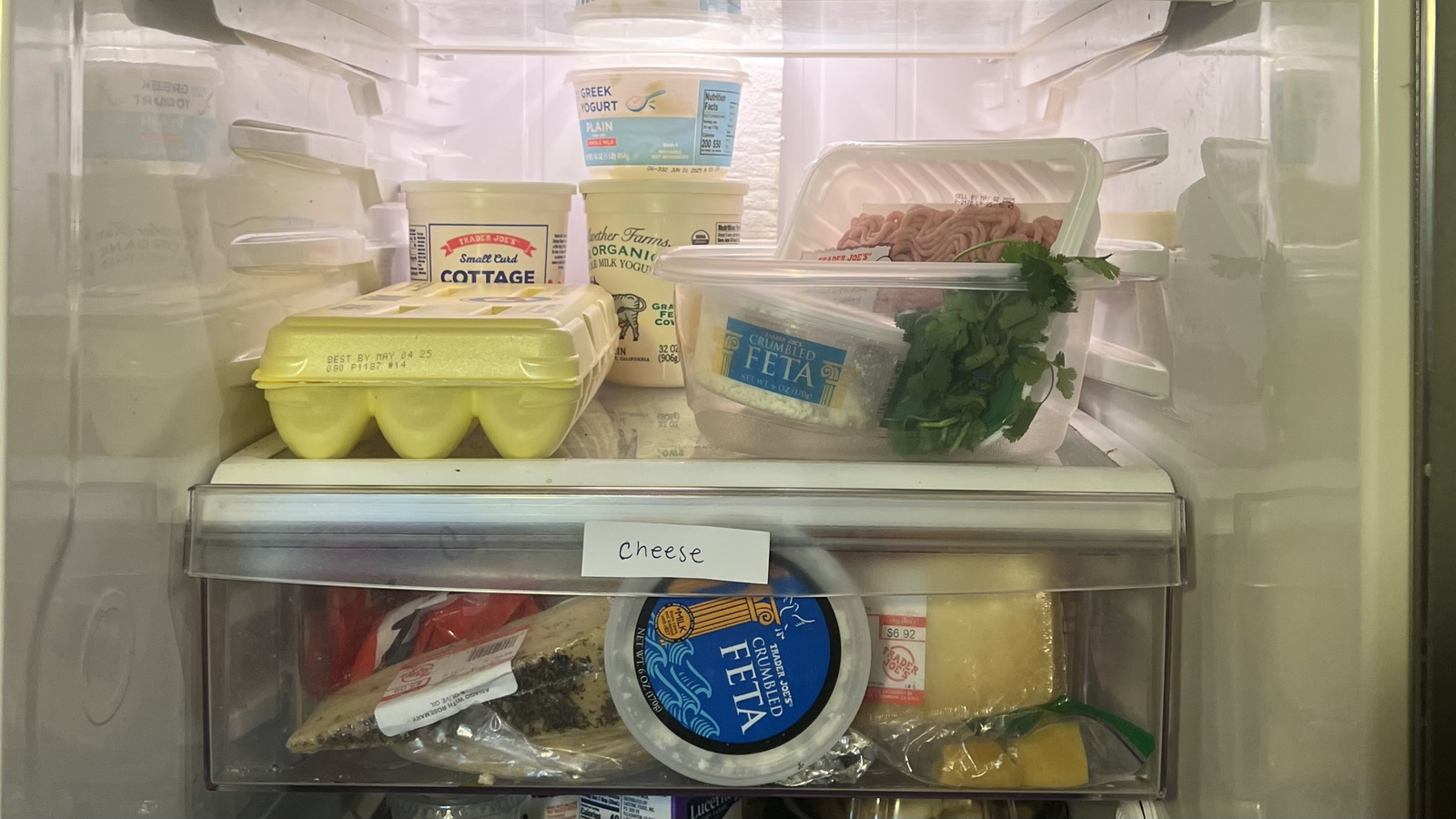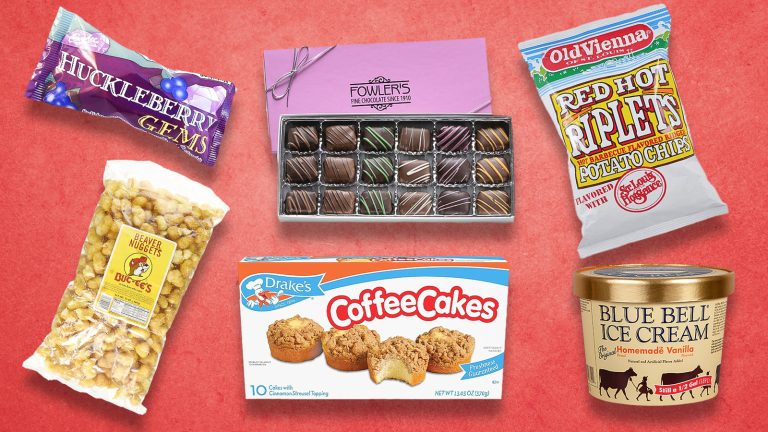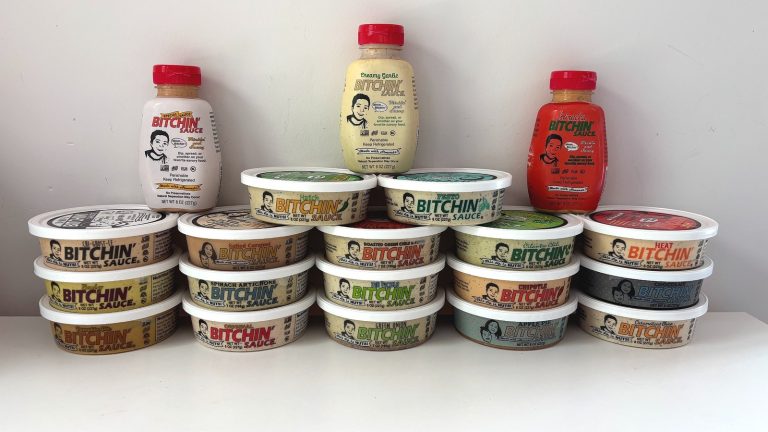We may receive a commission on purchases made from links.
Keeping a clean, organized refrigerator is an essential part of operating a functional kitchen, and yet it always feels like a daunting task. Whether because of leftovers that have been forgotten in the back or produce gone bad before you get a chance to use it, a disorganized refrigerator has consequences and can be frustrating to navigate.
Many standard refrigerators have designated organizational components to make this task easier and more intuitive. Crisper drawers, positioned at the bottom of your fridge, are designed to keep produce fresh. Cheese drawers placed in the middle of the fridge are in a cool spot to help keep dairy at a safe temperature. The built-in organization of refrigerators caters to the natural cold and hot spots of these appliances for optimal and safe food storage.
Still, these systems don’t work for everyone and can’t meet all fridge organization needs. For example, crisper drawers are deep and can allow produce to easily get lost. Sometimes, additional, more creative tools for fridge organization are needed. We put together 13 creative ways to organize your fridge to help optimize your space and minimize food waste.
Organize food in meal kits
Have you ever fully stocked your fridge for the week, and then still felt overwhelmed and like you had nothing to eat when dinner came around? If this sounds like you, try organizing the groceries in your fridge around meals. Creating meal kits is a simple and helpful technique that involves grouping the groceries you’re going to use for each of your meals together, so that they’re easy to find, and everything in your fridge has a place and a purpose.
If you want to go even further (but not quite into the realm of real meal prep), you could even chop and portion your ingredients before organizing them with each other, so all you have to do is throw things together on the stove when the time comes. This creative hack is excellent for both keeping your fridge organized and making your life in the kitchen easier.
Use baking pans as drawers
The back of your refrigerator is one of the most important yet underrated parts of the appliance. Typically one of the coldest areas of the fridge, the back should be utilized to keep meats and dairy at the most safe and stable temperatures. The back is also dangerous, though, because it is where many foods go to be forgotten about.
One creative way to ensure you’re utilizing the full depth of your fridge is to use baking pans as extra drawers. Instead of spending money on an additional tool, you can use metal baking sheets or glass baking pans to add some structure and mobility to your refrigerator organization. These cost-effective, makeshift drawers can slide in and out of the fridge as needed, so you get complete visibility of all your groceries, even those hidden deep in the back. This hack creates more optimized fridge space and less food waste. Best yet, these drawers are easy to remove and clean, so once you’ve eaten everything on your shelf, you can give your fridge a quick reset.
Store your herbs in the refrigerator door
Herbs are notoriously tricky to keep fresh in the fridge. Fresh herbs tend to wilt quickly, and after using them once, it’s easy to forget they’re even there. One day, you’re grabbing a vibrant bunch of cilantro from the produce aisle. Next, you’re unearthing a soggy, browning mess from the depths of your vegetable drawer. Thankfully, there’s a simple and creative way to extend their shelf life. It all starts with how you store them.
Rather than tossing your herbs into the crisper drawer, try storing them in the fridge door instead. Start by filling a mason jar or small container with water, then trim about an inch off the stems of your fresh herbs and place them in the jar with the leaves sticking out. Since most herbs don’t require super cold temperatures to stay fresh, the fridge door, typically the warmest part, is an ideal spot. This method not only prevents your herbs from getting crushed or forgotten but can also significantly extend their freshness. If you notice any wilting, try loosely covering the leaves with a plastic bag to create a humid microclimate, which can help them last even longer.
Use a lazy Susan for condiments
The condiments area of your refrigerator can easily become disorganized. Jars are indistinguishable from above when they have identical caps and can easily become hidden or forgotten. With a little bad luck, you’ll forget about that one perfect jam or think you have something you ran out of months ago. Condiments don’t technically even need to be refrigerated (a common food storage mistake), and also take up valuable fridge space that could be used for storing herbs or other items that need the door, such as open bottles of wine or tall sauces. If you want to try something new with your condiments, consider introducing a lazy Susan into your refrigerator.
Lazy Susans are among the best organizers because they can rotate a full 360 degrees to optimize accessibility. No longer will you struggle to find the short Dijon mustard jar hiding behind the ketchup. The lazy Susan can be placed on a lower shelf to store all of your shorter condiments and optimize space for other items. Plus, who doesn’t love a fun organization tool that spins?
It is important to find the right lazy Susan for your fridge. Many options are available in various shapes, sizes, and price points. We like this simple, budget option from Amazon, which is easy to clean and comes in a variety of sizes.
Repurpose a six-pack box to organize condiments
If you’re committed to using your fridge door space for condiments, but frustrated with them tipping over every time you close the refrigerator door, this hack may be for you. Empty six-pack boxes can be an effective way to keep your condiment shelf contained and well filed. Simply take the empty box, fill each slot with a condiment bottle, and fit as many of these organizers as you can into the fridge door. These boxes fit snugly into the shelf and will prevent the condiments from falling down. Because of their beverage-like shape, condiments are the ideal candidate for these recycled organizers, but they can be used all over your fridge for other beverages, yogurt containers, or whatever else you can fit in the narrow sleeves.
The one drawback to using a cardboard organizer is that it’s less durable than its plastic and glass counterparts. The good news is that these aren’t hard to replace. When a six-pack container goes soggy, it is time to repurpose a new one. There is nothing better than free fridge organization, especially with something that was already in your fridge. As the classic saying goes, reduce, reuse, recycle.
Keep a use-me-first bin
Food waste is an unintentional but unfortunate problem in most people’s kitchens. You wait to eat food until it’s no longer appealing, you buy ingredients with grand intentions of making a dish that you know you won’t make, or you just forget about the vegetables in the back of your fridge. It’s happened to all of us, and the solution to the problem might be a use-me-first bin. A use-me-first bin is exactly what it sounds like: a basket where you put all of the food you’re going to prioritize eating.
To make a use-me-first bin, you can use whatever container or basket you have lying around. Ideally, it shouldn’t be too big or too small. It shouldn’t get overwhelming, but should still hold a realistic amount of food. It should also ideally be something you can wipe down and clean easily, just in case you don’t end up using everything in time (we’re all human). Whether it’s leftovers, fruit that seems to go bad fast, or just something you know you need to eat first or it’s never going to get eaten, a use-me-first bin is a great technique to use so food doesn’t get forgotten.
Make a cut box
If you’ve ever used half an onion for a recipe, saved the rest for later, thrown it in your vegetable drawer, and then promptly forgotten about it, this hack is for you. Every frequent cook knows that you often don’t use a whole piece of produce for a single recipe. Once cut, though, produce is harder to keep fresh and will go bad more quickly. Compounded with a deep and disorganized produce drawer, half-used vegetables can be a source of frustration and food waste. This is where having a cut box comes in handy.
By designating a drawer or section of your fridge for all of your half-cut produce, you can more easily keep track of your leftover ingredients and prioritize using them quickly. Storage within this cut box is also important. Store your half-cut produce in an airtight, sealable container, plastic bag, or wrapped tightly in plastic wrap. Most produce, like onions and lemons, can last a few days when appropriately sealed in the refrigerator.
Keep track of leftovers on your refrigerator door
We’ve all brought home leftovers we were sure we were going to eat, and then promptly forgotten about. When you finally find them a week later, it feels like a tragic situation. You can approach trying to keep track of your leftovers, and everything really, with overcomplicated organization systems and fancy tools. Sometimes, though, the easiest way to ensure you don’t forget something is just to write it down. What better place to remind yourself of what’s inside your fridge than on your fridge itself? To use this hack, simply take a dry-erase marker, find an empty space on the front of your refrigerator, write the name of your leftovers, write the date next to it, and then erase it once it’s eaten. Trust us, there is nothing more convenient (and also secretly fun and rebellious) than writing and drawing all over your own fridge.
Before using this hack, check to make sure the dry-erase marker ink can be easily removed from your fridge. If you can’t write directly on your fridge, consider keeping a notepad attached to your fridge door or purchasing a magnetic whiteboard. This one from Amazon is the perfect size and comes at a low price point.
Label your fridge drawers
If you’re looking for a simple, budget-friendly hack that can totally transform your fridge setup, try labeling your shelves and drawers. It’s one of the easiest organizational tricks out there, but it makes a big difference by giving everything a designated home. Most fridge interiors’ plastic shelves and bins are durable enough to handle labels, and this approach doesn’t require buying bulky organizers that may be difficult to fit. You can use sticky labels, tape on paper tags, or even write directly on surfaces with a dry-erase marker for a low-effort, high-impact solution.
The best part about the hack is that you can have fun and get creative with the sections and labels you create. Consider making a drink shelf or drawer for sandwich materials and decorating your labels to make them extra fun and enticing to use.
Install command hooks for extra space
If you’ve organized your fridge to the fullest, but still feel like there isn’t enough space for all of your groceries, consider turning the sides of your fridge into available real estate. One easy and cost-effective way to do this is to add hooks. Command hooks stick easily to the inside of your fridge walls and can be used to hang bags for produce or other various items that don’t have an obvious home around your refrigerator.
This technique is especially great as a last resort for storing items that don’t necessarily need to be refrigerated. For example, fruits like apples, citrus, and avocados don’t need to be stored inside the fridge, but can have their shelf lives prolonged if they are. Hanging them works well to protect their softer and more delicate skin, so they don’t bruise in the vegetable drawer. Command hooks can be purchased at most general merchandise stores. We like these command hooks from Amazon that are durable and easy to install.
Hang a magnetic fridge shelf
One of the most underrated features of a refrigerator is its magnetism. While travel magnets have long been a fridge staple, it might be time to upgrade your magnet game with something more functional, like a magnetic shelf. These external shelves are perfect for anyone with a magnetic fridge front and can add a surprising amount of extra storage. While they won’t provide additional cooling, they’re great for holding items you’re tempted to refrigerate but don’t need to, like tomatoes, avocados, or bananas.
A little extra storage never hurts, especially in a small kitchen where your main appliances might just be a fridge and a stove. When cabinet space is limited, finding clever ways to make your appliances work harder is key. The magnetic shelf is a simple, affordable solution that can help maximize vertical space and keep everyday items within easy reach. You can purchase a magnetic fridge shelf on Amazon. This one is simple, versatile, and cost-effective.
Keep a snack basket
Sometimes, it feels like there’s nothing to eat when you’ve forgotten that the perfect snack is hiding behind a milk jug. When you’re hungry, the last thing you want to do is dig through your fridge in search of something satisfying. To make those moments easier (and your fridge a little more fun), try creating a designated snack drawer or snack basket.
A snack basket is a great way to keep no-cook, grab-and-go options front and center. The idea is to make snacking effortless, no overthinking required. You can even take it a step further by prepping mini snack kits in advance. Think hummus with carrot sticks, apple slices with peanut butter, or pre-cut watermelon. With everything ready to grab, your future hungry self will thank you.





